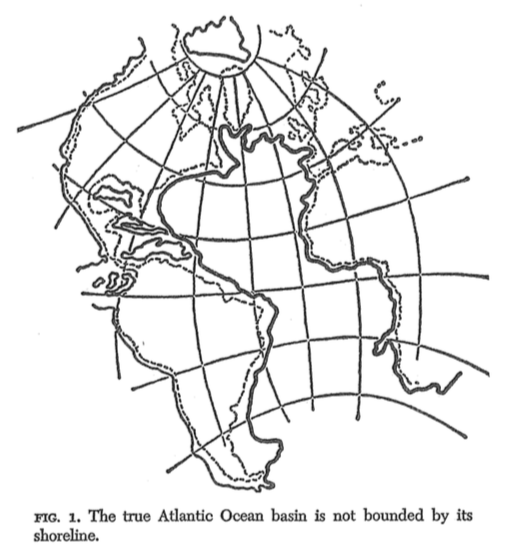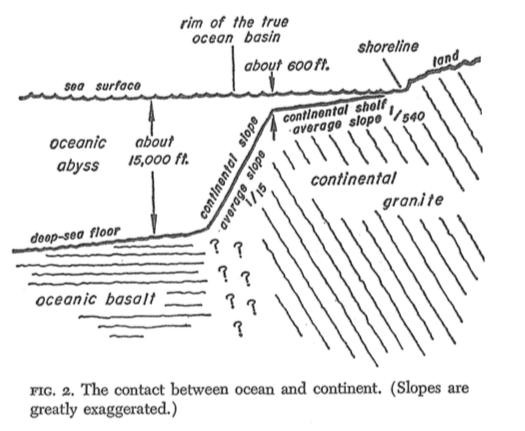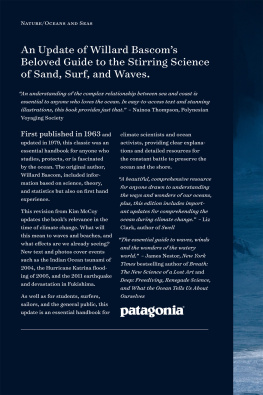Willard Bascom - Waves and beaches: the dynamics of the ocean surface /
Here you can read online Willard Bascom - Waves and beaches: the dynamics of the ocean surface / full text of the book (entire story) in english for free. Download pdf and epub, get meaning, cover and reviews about this ebook. City: Garden City, N.Y. :, year: 1980., publisher: Anchor Press,, genre: Children. Description of the work, (preface) as well as reviews are available. Best literature library LitArk.com created for fans of good reading and offers a wide selection of genres:
Romance novel
Science fiction
Adventure
Detective
Science
History
Home and family
Prose
Art
Politics
Computer
Non-fiction
Religion
Business
Children
Humor
Choose a favorite category and find really read worthwhile books. Enjoy immersion in the world of imagination, feel the emotions of the characters or learn something new for yourself, make an fascinating discovery.

- Book:Waves and beaches: the dynamics of the ocean surface /
- Author:
- Publisher:Anchor Press,
- Genre:
- Year:1980.
- City:Garden City, N.Y. :
- Rating:5 / 5
- Favourites:Add to favourites
- Your mark:
- 100
- 1
- 2
- 3
- 4
- 5
Waves and beaches: the dynamics of the ocean surface /: summary, description and annotation
We offer to read an annotation, description, summary or preface (depends on what the author of the book "Waves and beaches: the dynamics of the ocean surface /" wrote himself). If you haven't found the necessary information about the book — write in the comments, we will try to find it.
Waves and beaches: the dynamics of the ocean surface / — read online for free the complete book (whole text) full work
Below is the text of the book, divided by pages. System saving the place of the last page read, allows you to conveniently read the book "Waves and beaches: the dynamics of the ocean surface /" online for free, without having to search again every time where you left off. Put a bookmark, and you can go to the page where you finished reading at any time.
Font size:
Interval:
Bookmark:
For those who wish to go a little deeper into the subject of waves and hear a different point of view, see:
E.P. Clancy. The Tides: Pulse of the Earth. Garden City, N.Y.: Doubleday & Company, 1968.
Adlard K. Coles. Heavy Weather Sailing. Tuckahoe, N.Y.: John de Graff, 1975.
H.A. and M.C. Klein. Surfs Up! An Anthology of Surfing. New York: Bobbs-Merrill Co., 1966.
W.G. Van Dorn. Oceanography and Seamanship. New York: Dodd, Mead & Co., 1974.
You can go very much deeper into waves with either of two mathematical treatments:
Blair Kinsman. Wind Waves: Their Generation and Propagation on the Ocean Surface. Englewood Cliffs, N.J.: Prentice Hall, 1965.
O.M. Phillips. The Dynamics of the Upper Ocean. Cambridge, England: Cambridge University Press, 1966.
On Beaches and Shorelines:
F.P. Shepard. Submarine Geology. New York: Harper and Row, 1973.
C.A.M. King. Beaches and Coasts. New York: St. Martins Press, 1960.
On shoreline engineering and naval architecture:
U.S. Army Corps of Engineers, Coastal Engineering Research Center. Shore Protection Manual. 1977.
Harold Saunders, Hydrodynamics in Ship Design. New York: Society of Naval Architects & Marine Engineers, 1965.
Edward V. Lewis. Ships. New York: Time-Life Books, 1965.
Waves in literature:
Homer. The Odyssey. E.V. Rieu, transl. New York: Penguin Books, 1946.
Joshua Slocum. Sailing Alone Around the World. New York: Sheridan House, 1954.
Charles Darwin. The Voyage of the Beagle. New York: Bantam Books, 1972.
Joseph Conrad. Typhoon. New York: Bantam Books, 1971.
Arthur C. Clarke. Rendezvous with Rama. New York: Ballantine Books, 1974.
Waves are undulating forms that move along the surface of the sea. They may exist on the interface between any two fluids of different density, but this book will deal primarily with those that travel on the surface between ocean and atmosphere. While any kind of disturbance in the water is likely to generate waves, there are three prime natural causes: wind, earthquakes, and the gravitational pull of the moon and the sun.
Wind waves are the most familiar kind; they are also most variable and in many ways the most puzzling. The size and variety of the waves raised by the wind depend on three factors: the velocity of the wind, the distance it blows across the water, the length of time it blows. Moreover, the character of the waves changes markedly as they move away from winds that created them.
The earthquake mechanism is simpler. A rapid motion of the subsea rocks disturbs a mass of water. In regaining its equilibrium the water surface oscillates up and down and sends out a series of seismic sea waves, collectively called a tsunami.
The tides, which are a special kind of very long wave, are caused by the earths turning beneath great bulges of water raised by the combined gravitational fields of the moon and the sun.
However generated, the character of waves and the velocity at which they move are influenced by the depth of the water in which they are traveling. Therefore, in order to understand the behavior of waves, one must also know something about the shapes of the rocky basins that hold the water. Consider the beginnings of the water and the land - the origin of the earths surface features.
The earth formed from rocky and metallic fragments left over from the construction of the sun - debris that was swept up by a rocky nucleus and attracted together into a single body by the force of gravity. The original materials were cold as outer space and dry as dust; whatever water and gases they contained were locked inside individual fragments as chemical compounds. The impact of the collisions as the fragments joined, plus the enormous internal pressure caused by gravity, caused the new earth to heat up. It may never have been any hotter than it is now, but the internal temperature was such that the compounds broke down, releasing the water and gases. Plastic flow could occur. Segregation by density began, and the earth started to organize into its present layered structure. The heaviest metals sank to the center; the lightest materials migrated outward.
In time the lightest rocks - granites - reached the surface and collected into the large blocks now known as continents. Between them were broad basaltic lowlands, which became the ocean basins. At the same time water and gases were brought to the surface by volcanic activity. Slowly the ocean basins filled and an atmosphere formed. In a few billion years the ocean was full and the atmosphere was sufficiently dense that effective winds could exist to transport water vapor. As soon as the evaporation-condensation cycle could operate, rains fell and stream erosion began. Fragments of continental rock were carried downhill by the running water and deposited in the ocean. The coarser particles were deposited close to shore; the finer ones were carried out to deep water, where they formed sedimentary deposits that tended to smooth the sea floor and raise the sea level. The motions of the new atmosphere created the first waves and these waves began the attack on the primordial shorelines. Then as now the waves undermined sea cliffs, bringing down large chunks of rock, which were patiently ground against each other by the moving water to form sand. The sand mined from the cliffs and the sand mined inland by streams were intermingled, sorted, and redistributed along the shore. The first beaches formed.
Figure 1

As these processes proceed (the segregation of materials in the earths interior is still going on and new water still comes to the surface) the level of the ocean has risen above the edge of its natural basin. Now the edges of the continental blocks have been flooded to an average depth of six hundred feet; now as many shorelines are sandy as rocky.
It is well to remember that although the shoreline is important as the place where land and water meet, it is not the rim of the ocean in the geological sense. The true ocean basin begins well offshore where the edge of the continental rock slopes steeply into the abyss. In the basin the average water depth is nearly fifteen thousand feet and the great waves race along at high speeds; on the shallow shelves these same waves are slowed by the drag of the bottom. Thus it is on the shallow continental shelves that many of the phenomena described in this book occur. There waves moving landward from the deep ocean are transformed as they first feel the bottom; there beaches are created and constantly rearranged; there shoreline works must meet and resist the force of the oceans waves.
Waves come in many kinds and sizes; it is best to think of them as a continuous spectrum extending from waves so small they can hardly be seen to waves so long they are not noticed. Somewhere in the midst of the spectrum are the waves with which we are all familiar.
Waves range in size from the ripples in a pond to the great storm waves of the ocean and the tides whose wave length is half the distance around the earth. In order to be able to discuss such widely varying kinds and sizes of waves it is necessary to agree on a standard set of names for the parts of a wave.
Figure 2

The principal ones are defined as follows:
Crest: The high point of a wave
Trough: The low point of a wave
Font size:
Interval:
Bookmark:
Similar books «Waves and beaches: the dynamics of the ocean surface /»
Look at similar books to Waves and beaches: the dynamics of the ocean surface /. We have selected literature similar in name and meaning in the hope of providing readers with more options to find new, interesting, not yet read works.
Discussion, reviews of the book Waves and beaches: the dynamics of the ocean surface / and just readers' own opinions. Leave your comments, write what you think about the work, its meaning or the main characters. Specify what exactly you liked and what you didn't like, and why you think so.






